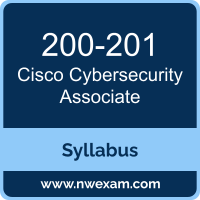 A great way to start the Cisco Certified Cybersecurity Associate (CBROPS) preparation is to begin by properly appreciating the role that syllabus and study guide play in the Cisco 200-201 certification exam. This study guide is an instrument to get you on the same page with Cisco and understand the nature of the Cisco Cybersecurity Associate exam.
A great way to start the Cisco Certified Cybersecurity Associate (CBROPS) preparation is to begin by properly appreciating the role that syllabus and study guide play in the Cisco 200-201 certification exam. This study guide is an instrument to get you on the same page with Cisco and understand the nature of the Cisco Cybersecurity Associate exam.
Our team of experts has composed this Cisco 200-201 exam preparation guide to provide the overview about Understanding Cisco Cybersecurity Operations Fundamentals exam, study material, sample questions, practice exam and ways to interpret the exam objectives to help you assess your readiness for the Cisco CBROPS exam by identifying prerequisite areas of knowledge. We recommend you to refer the simulation questions and practice test listed in this guide to determine what type of questions will be asked and the level of difficulty that could be tested in the Cisco Cybersecurity Associate certification exam.
Cisco 200-201 Exam Overview:
| Exam Name | Understanding Cisco Cybersecurity Operations Fundamentals |
| Exam Number | 200-201 CBROPS |
| Exam Price | $300 USD |
| Duration | 120 minutes |
| Number of Questions | 95-105 |
| Passing Score | Variable (750-850 / 1000 Approx.) |
| Recommended Training |
Understanding Cisco Cybersecurity Operations Fundamentals | CBROPS Understanding Cisco Cybersecurity Operations Fundamentals (CBROPS) v1.2 |
| Exam Registration | PEARSON VUE |
| Sample Questions | Cisco 200-201 Sample Questions |
| Practice Exam | Cisco Certified Cybersecurity Associate Practice Test |
Cisco 200-201 Exam Topics:
| Section | Weight | Objectives |
|---|---|---|
| Security Concepts | 20% |
- Describe the CIA triad - Compare security deployments
- Describe security terms
- Compare security concepts
- Describe the principles of the defense-in-depth strategy
- Describe terms as defined in CVSS
- Identify the challenges of data visibility (network, host, and cloud) in detection |
| Security Monitoring | 25% |
- Compare attack surface and vulnerability - Identify the types of data provided by these technologies
- Describe the impact of these technologies on data visibility
- Describe the uses of these data types in security monitoring
- Describe network attacks, such as protocol-based, denial of service, distributed denial of service, and man-in-the-middle
|
| Host-Based Analysis | 20% |
- Describe the functionality of these endpoint technologies in regard to security monitoring utilizing rules, signatures, and predictive AI
- Identify components of an operating system (such as Windows and Linux) in a given scenario
- Identify type of evidence used based on provided logs
- Interpret operating system, SIEM, SOAR platform, application, or command line logs to identify event
|
| Network Intrusion Analysis | 20% |
- Map the provided events to source technologies
- Compare impact and no impact for these items
- Compare deep packet inspection with packet filtering and stateful firewall operation
- Interpret the fields in protocol headers as related to intrusion analysis
- Interpret common artifact elements from an event to identify an alert
- Interpret basic regular expressions |
| Security Policies and Procedures | 15% |
- Describe management concepts
- Describe the elements in an incident response plan as stated in NIST.SP800-61
- Map the organization stakeholders against the NIST IR categories (CMMC, NIST.SP800-61)
- Describe concepts as documented in NIST.SP800-86
- Identify these elements used for network profiling
- Identify these elements used for server profiling
- Identify protected data in a network
- Classify intrusion events into categories as defined by security models, such as Cyber Kill Chain Model and Diamond Model of Intrusion |
Cisco CBROPS Exam Description:
Understanding Cisco Cybersecurity Operations Fundamentals v1.2 (CBROPS 200- 201 is a 120-minute exam that is associated with the Cisco Certified CyberOps Associate Certification. This exam certifies a candidate’s knowledge and skills related to security concepts, security monitoring, host-based analysis, network intrusion analysis, and security policies and procedures. The course, Understanding Cisco Cybersecurity Operations Fundamentals, helps candidates to prepare for this exam.
